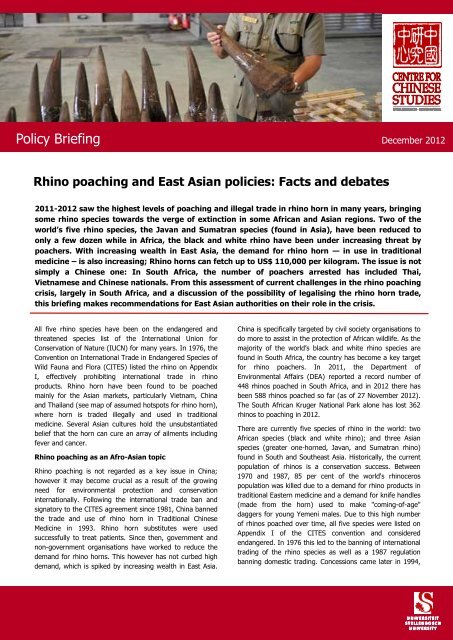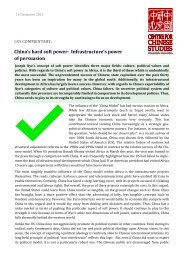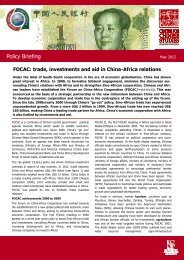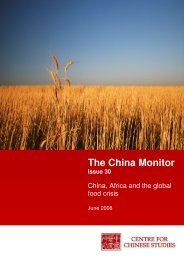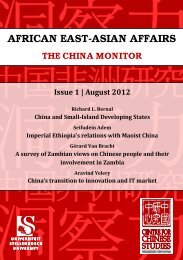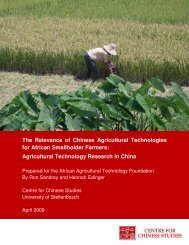Rhino poaching and East Asian policies - The Centre for Chinese ...
Rhino poaching and East Asian policies - The Centre for Chinese ...
Rhino poaching and East Asian policies - The Centre for Chinese ...
You also want an ePaper? Increase the reach of your titles
YUMPU automatically turns print PDFs into web optimized ePapers that Google loves.
Policy Briefing December 2012<br />
<strong>Rhino</strong> <strong>poaching</strong> <strong>and</strong> <strong>East</strong> <strong>Asian</strong> <strong>policies</strong>: Facts <strong>and</strong> debates<br />
2011-2012 saw the highest levels of <strong>poaching</strong> <strong>and</strong> illegal trade in rhino horn in many years, bringing<br />
some rhino species towards the verge of extinction in some African <strong>and</strong> <strong>Asian</strong> regions. Two of the<br />
world’s five rhino species, the Javan <strong>and</strong> Sumatran species (found in Asia), have been reduced to<br />
only a few dozen while in Africa, the black <strong>and</strong> white rhino have been under increasing threat by<br />
poachers. With increasing wealth in <strong>East</strong> Asia, the dem<strong>and</strong> <strong>for</strong> rhino horn — in use in traditional<br />
medicine – is also increasing; <strong>Rhino</strong> horns can fetch up to US$ 110,000 per kilogram. <strong>The</strong> issue is not<br />
simply a <strong>Chinese</strong> one: In South Africa, the number of poachers arrested has included Thai,<br />
Vietnamese <strong>and</strong> <strong>Chinese</strong> nationals. From this assessment of current challenges in the rhino <strong>poaching</strong><br />
crisis, largely in South Africa, <strong>and</strong> a discussion of the possibility of legalising the rhino horn trade,<br />
this briefing makes recommendations <strong>for</strong> <strong>East</strong> <strong>Asian</strong> authorities on their role in the crisis.<br />
All five rhino species have been on the endangered <strong>and</strong><br />
threatened species list of the International Union <strong>for</strong><br />
Conservation of Nature (IUCN) <strong>for</strong> many years. In 1976, the<br />
Convention on International Trade in Endangered Species of<br />
Wild Fauna <strong>and</strong> Flora (CITES) listed the rhino on Appendix<br />
I, effectively prohibiting international trade in rhino<br />
products. <strong>Rhino</strong> horn have been found to be poached<br />
mainly <strong>for</strong> the <strong>Asian</strong> markets, particularly Vietnam, China<br />
<strong>and</strong> Thail<strong>and</strong> (see map of assumed hotspots <strong>for</strong> rhino horn),<br />
where horn is traded illegally <strong>and</strong> used in traditional<br />
medicine. Several <strong>Asian</strong> cultures hold the unsubstantiated<br />
belief that the horn can cure an array of ailments including<br />
fever <strong>and</strong> cancer.<br />
<strong>Rhino</strong> <strong>poaching</strong> as an Afro-<strong>Asian</strong> topic<br />
<strong>Rhino</strong> <strong>poaching</strong> is not regarded as a key issue in China;<br />
however it may become crucial as a result of the growing<br />
need <strong>for</strong> environmental protection <strong>and</strong> conservation<br />
internationally. Following the international trade ban <strong>and</strong><br />
signatory to the CITES agreement since 1981, China banned<br />
the trade <strong>and</strong> use of rhino horn in Traditional <strong>Chinese</strong><br />
Medicine in 1993. <strong>Rhino</strong> horn substitutes were used<br />
successfully to treat patients. Since then, government <strong>and</strong><br />
non-government organisations have worked to reduce the<br />
dem<strong>and</strong> <strong>for</strong> rhino horns. This however has not curbed high<br />
dem<strong>and</strong>, which is spiked by increasing wealth in <strong>East</strong> Asia.<br />
China is specifically targeted by civil society organisations to<br />
do more to assist in the protection of African wildlife. As the<br />
majority of the world’s black <strong>and</strong> white rhino species are<br />
found in South Africa, the country has become a key target<br />
<strong>for</strong> rhino poachers. In 2011, the Department of<br />
Environmental Affairs (DEA) reported a record number of<br />
448 rhinos poached in South Africa, <strong>and</strong> in 2012 there has<br />
been 588 rhinos poached so far (as of 27 November 2012).<br />
<strong>The</strong> South African Kruger National Park alone has lost 362<br />
rhinos to <strong>poaching</strong> in 2012.<br />
<strong>The</strong>re are currently five species of rhino in the world: two<br />
African species (black <strong>and</strong> white rhino); <strong>and</strong> three <strong>Asian</strong><br />
species (greater one-horned, Javan, <strong>and</strong> Sumatran rhino)<br />
found in South <strong>and</strong> Southeast Asia. Historically, the current<br />
population of rhinos is a conservation success. Between<br />
1970 <strong>and</strong> 1987, 85 per cent of the world's rhinoceros<br />
population was killed due to a dem<strong>and</strong> <strong>for</strong> rhino products in<br />
traditional <strong>East</strong>ern medicine <strong>and</strong> a dem<strong>and</strong> <strong>for</strong> knife h<strong>and</strong>les<br />
(made from the horn) used to make "coming-of-age"<br />
daggers <strong>for</strong> young Yemeni males. Due to this high number<br />
of rhinos poached over time, all five species were listed on<br />
Appendix I of the CITES convention <strong>and</strong> considered<br />
endangered. In 1976 this led to the banning of international<br />
trading of the rhino species as well as a 1987 regulation<br />
banning domestic trading. Concessions came later in 1994,
<strong>Rhino</strong> <strong>poaching</strong> <strong>and</strong> <strong>East</strong> <strong>Asian</strong> <strong>policies</strong>: Facts <strong>and</strong> debates<br />
(an Appendix II down-listing <strong>for</strong> South Africa’s white rhino<br />
population to allow <strong>for</strong> trophy hunting <strong>and</strong> live sales) <strong>and</strong><br />
2004 (a similar down-listing <strong>for</strong> Swazil<strong>and</strong> <strong>and</strong> limited black<br />
rhino trophy hunting quotas <strong>for</strong> South Africa <strong>and</strong> Namibia).<br />
Although the ban on trading horn has been in <strong>for</strong>ce since<br />
then, illegal trading of rhino horn continues today. Some<br />
rhino species are close to extinction again: In 2011, the<br />
WWF <strong>and</strong> the International <strong>Rhino</strong> Foundation confirmed the<br />
extinction of the Javan rhino in Vietnam. <strong>The</strong> Javan<br />
rhinoceros is now believed to be confined to one population,<br />
less than 50 individuals, in a small national park in<br />
Indonesia.<br />
<strong>The</strong> rapid economic development experienced by China in<br />
recent years has further created new challenges <strong>and</strong><br />
opportunities <strong>for</strong> the conservation <strong>and</strong> sustainable use of<br />
wild animals <strong>and</strong> plants, such as snakes, crocodiles, ginseng,<br />
tropical timber species, turtles, seahorses <strong>and</strong> other marine<br />
species. From a traditional <strong>Chinese</strong> perspective, as in many<br />
other countries, wild animals are a resource to be exploited,<br />
not something to be protected <strong>for</strong> their intrinsic value.<br />
However as more people are able to af<strong>for</strong>d traditional<br />
Box 1: Regulation of Traditional <strong>Chinese</strong><br />
Medicine (TCM)<br />
A way of addressing the use of banned wildlife parts <strong>for</strong><br />
traditional medicine was through the regulation of<br />
traditional <strong>Chinese</strong> medicine practices. <strong>Chinese</strong> herbal<br />
medicine production, distribution, pricing, <strong>and</strong> utilisation<br />
are under the regulations of different government<br />
agencies, such as the <strong>Chinese</strong> State Food <strong>and</strong> Drug<br />
Administration <strong>and</strong> the National Development <strong>and</strong><br />
Re<strong>for</strong>m Commission. Although the <strong>Chinese</strong> government<br />
has implemented quality control systems on medical<br />
production, such as implementations of the Good<br />
Agricultural Practice (GAP), the Good Laboratory<br />
Practice (GLP), <strong>and</strong> the Good Manufacturing Practice<br />
(GMP), the quality control in the production of herbal<br />
medicine still needs to improve.<br />
Since 1999, TCM has also been under the same<br />
registration <strong>and</strong> licensing procedures as western<br />
medicine. In addition to regular training, both doctors<br />
<strong>and</strong> pharmacists are required to do one to three years<br />
of residency in a medical institution be<strong>for</strong>e taking a<br />
national license examination. TCM is a practical study,<br />
emphasising clinical experience as well as family<br />
lineage. Those TCM practitioners who have studied<br />
traditional medicine can also participate in the<br />
examination of medical practitioners. However, the<br />
complex process <strong>and</strong> certain requirements of the exam<br />
(e.g. some specific western medical science knowledge)<br />
prevent some TCM practitioners from getting their<br />
licenses. It should be noted that TCM is used globally<br />
<strong>and</strong> thus requires regulations across countries.<br />
medicine, mounting pressure on conservation simultaneously<br />
leads to greater environmental awareness.<br />
En<strong>for</strong>cement of regulation (see box 1) is crucial on the<br />
supply side. <strong>The</strong>re is however also a strong dem<strong>and</strong> side of<br />
the problem. <strong>The</strong> key to success of CITES lies in the<br />
willingness of member states to en<strong>for</strong>ce its resolutions. <strong>The</strong><br />
continued trade of rhino horn illustrates problems with<br />
en<strong>for</strong>cement mechanisms. China, a CITES signatory, remains<br />
one of the world's top destinations <strong>for</strong> illegal rhino horn as<br />
reported by the IUCN Species Survival Commission (SSC).<br />
Wildlife law en<strong>for</strong>cement in China<br />
Law en<strong>for</strong>cement of the sale <strong>and</strong> trade of rhino horn is a<br />
major issue in <strong>East</strong> Asia; however, very few arrests have<br />
been made in China, Vietnam or Thail<strong>and</strong>. In contrast, of the<br />
43 documented arrests of <strong>Asian</strong> nationals <strong>for</strong> rhino crimes in<br />
South Africa, 24 have been Vietnamese, 13 <strong>Chinese</strong> <strong>and</strong> the<br />
remainder from Thail<strong>and</strong> <strong>and</strong> Malaysia, reports TRAFFIC, a<br />
wildlife trade monitoring network. <strong>The</strong> <strong>Chinese</strong> authorities<br />
have begun to take some action - China’s wildlife law<br />
en<strong>for</strong>cement authorities taking positive steps to tackle the<br />
issue through en<strong>for</strong>cement actions <strong>and</strong> by holding<br />
interagency workshops on the control of illegal online wildlife<br />
trade (see table 1 <strong>for</strong> the WWF Crime Scorecard). <strong>The</strong><br />
inaugural meeting of China’s National Inter-Agencies CITES<br />
En<strong>for</strong>cement Coordination Group (NICECG) was held in<br />
Beijing in November 2011 in order to enhance ef<strong>for</strong>ts by<br />
China’s responsible government agencies to combat<br />
smuggling <strong>and</strong> illegal wildlife trade in China.<br />
In June 2012 <strong>Chinese</strong> authorities stepped up on the online<br />
selling of rhino horn. TRAFFIC reported that 15 of the<br />
leading e-commerce sellers, operating in China, have signed<br />
a declaration stating that they have a zero-tolerance policy<br />
towards their services being used to conduct illegal wildlife<br />
trading. This was after TRAFFIC had found 3,389<br />
advertisements <strong>for</strong> tiger bone, elephant ivory, rhino horn <strong>and</strong><br />
hawksbill turtle products being offered through 15 <strong>Chinese</strong>language<br />
e-commerce sites <strong>and</strong> associated auction websites<br />
<strong>and</strong> chat rooms in April 2012.<br />
To legalise trade, or not?<br />
In Vietnam, rhino horns (including fake horn) are being sold<br />
through traditional medicine stores <strong>and</strong> hospitals. <strong>Rhino</strong> horn<br />
smugglers are now making very high quality fake horns,<br />
allowing hunters to sell the real horns at a huge mark-up to<br />
black market dealers <strong>for</strong> traditional medicine <strong>and</strong> status<br />
symbols. Horn is nowadays even stolen from museums <strong>and</strong><br />
private hunters' homes.<br />
Some experts believe that selling off the rhino horn will halt<br />
the need <strong>for</strong> the black market, as well as bring the value of
December 2012<br />
November 2011<br />
Assessing China’s Role in Foreign Direct<br />
Investment in Southern Africa<br />
March 2011<br />
Box 2: <strong>Rhino</strong> trade, the legal way?<br />
<strong>Rhino</strong> horn trade is regulated by CITES <strong>and</strong> at present,<br />
only South Africa is allowed to export rhino horn. CITES<br />
regulations state only the white rhino can be traded<br />
legally in South Africa <strong>and</strong> Swazil<strong>and</strong> “<strong>for</strong> the exclusive<br />
purpose of allowing international trade in live animals to<br />
appropriate <strong>and</strong> acceptable destinations <strong>and</strong> hunting<br />
trophies.” It has been found that only about 15 rhinos are<br />
shot in true trophy hunts in South Africa every year, while<br />
about 200 are shot each year, in pseudo-trophy hunts<br />
where the hunt is solely interested in the horn <strong>for</strong> selling<br />
into the <strong>Asian</strong> market. <strong>The</strong> number of Vietnamese<br />
awarded permits has decreased after this finding.<br />
Live rhinos have also been exported to various countries<br />
from South Africa, especially to China. Over 100 rhinos<br />
have been exported to China, some of which cannot be<br />
accounted <strong>for</strong>. South Africa reported exporting 61 rhinos<br />
to China in 2006 <strong>and</strong> 2007, whilst China recorded<br />
receiving 117 rhinos from South Africa during the same<br />
time (IUCN/SSC report, 2009). <strong>The</strong> mismatch in numbers<br />
clearly illustrates irregularities in the export of live rhino<br />
from South Africa.<br />
the rhino horn down. DEA argues that rhino horn stock piles<br />
could also be sold to fund further rhino conservation ef<strong>for</strong>ts.<br />
<strong>The</strong> call <strong>for</strong> legalising the trade has, however, drawn much<br />
criticism from international conservation NGOs such as WWF,<br />
which claim this would set back ef<strong>for</strong>ts made to stabilise<br />
rhino populations by decades <strong>and</strong> would only further<br />
endanger the lives of rhino - <strong>and</strong> possibly drive them to<br />
extinction. Also, ‘legal production’ of rhino horn is unlikely to<br />
saturate a market that is rapidly exp<strong>and</strong>ing due to rapidly<br />
increasing wealth in Asia.<br />
A possible legalisation of rhino trade would need a long<br />
discussion on the best possible process <strong>for</strong> the protection of<br />
the rhino – instead of the economic gains made by the<br />
trading of rhino horn. If legal trade was to become an option,<br />
CITES would need to approve a change in the rules, <strong>and</strong> <strong>for</strong><br />
that to happen, 66 per cent of the 175 member countries<br />
need to vote in favour of the change. A number of issues<br />
would have to be addressed, including the identification of a<br />
trade partner that will control trade in the country of import<br />
<strong>and</strong> reliable certification <strong>and</strong> monitoring systems. South<br />
Africa has suspended its ef<strong>for</strong>ts <strong>for</strong> the legalisation of rhino<br />
horn trade as there is not enough time to prepare the<br />
application be<strong>for</strong>e the next CITES meeting in 2013.<br />
Botswana seems to generally be going the opposite direction<br />
<strong>and</strong> has announced a complete ban on trophy hunting <strong>for</strong><br />
any game in 2014 in November 2012.<br />
Conclusions <strong>and</strong> Recommendations<br />
Need is <strong>for</strong> a clear commitment of <strong>East</strong> <strong>Asian</strong> states to work<br />
with African states on environmental protection. Advocacy is<br />
apparently achieving effects; it is believed that the negative<br />
publicity Vietnam has received recently has spurred some<br />
action. Vietnam posted the highest wildlife crime score in the<br />
WWF’s 2012 Wildlife Crime Scorecard report (see table 1).<br />
South Africa <strong>and</strong> Vietnam — after administrative hiccups –<br />
have signed a Memor<strong>and</strong>um of Underst<strong>and</strong>ing that will<br />
encompass bilateral cooperation in criminal investigations<br />
against illegal wildlife trafficking.<br />
Ironically, the rhino <strong>poaching</strong> crisis is particularly harmful to<br />
China’s image, given that talk often is about <strong>Chinese</strong><br />
traditional medicine. <strong>The</strong> existing regulation within China<br />
does not seem to be the weak point. China is signatory to a<br />
Table 1: Compliance <strong>and</strong> en<strong>for</strong>cement scores <strong>for</strong> destination countries<br />
Countries are scored green, yellow or red in an assessment of their recent ef<strong>for</strong>ts to comply with <strong>and</strong> en<strong>for</strong>ce CITES trade<br />
controls <strong>for</strong> the three species groups.<br />
Green - General progress in key aspects of compliance <strong>and</strong> en<strong>for</strong>cement<br />
Yellow - Failing on key aspects of compliance or en<strong>for</strong>cement<br />
Red - Failing on key aspects of compliance <strong>and</strong> en<strong>for</strong>cement<br />
Country <strong>Rhino</strong> Tiger Elephant<br />
China<br />
Thail<strong>and</strong><br />
Vietnam<br />
Source: WWF Wildlife Crime Scorecard 2012
<strong>Rhino</strong> <strong>poaching</strong> <strong>and</strong> <strong>East</strong> <strong>Asian</strong> <strong>policies</strong>: Facts <strong>and</strong> debates<br />
December 2012<br />
Hotspot of illegal rhino horn trade<br />
number of environmental/conservation regulation, including<br />
international agreements. <strong>The</strong> regulation side is thus very<br />
much with the international consensus. Also in place is<br />
regulation of Traditional <strong>Chinese</strong> Medicine which – in theory<br />
– is also complying with the above international st<strong>and</strong>ards.<br />
<strong>The</strong>re are still traditional medicine practitioners who are<br />
promoting the product.<br />
Most <strong>Asian</strong> states legally provide full protection to rhino<br />
species under their respective wildlife protection acts.<br />
Penalties stipulated in the legislation are generally high, but<br />
convictions are few <strong>and</strong> sentences often lenient. Capturing<br />
rhino poachers <strong>and</strong> traders, <strong>and</strong> collecting sufficient evidence<br />
<strong>for</strong> successful convictions, has proved challenging. Thus, law<br />
en<strong>for</strong>cement needs to be improved in China.<br />
Law en<strong>for</strong>cement needs explicitly both, dem<strong>and</strong> <strong>and</strong> supply<br />
side ef<strong>for</strong>ts. <strong>The</strong>re<strong>for</strong>e, <strong>Chinese</strong> authorities <strong>and</strong> NGOs need<br />
to create more environmental awareness, not only on the<br />
importance of protecting wildlife, but specifically aiming at<br />
demystifying the value <strong>and</strong> power of rhino horn.<br />
Further recommendations need to be made <strong>for</strong> South Africa,<br />
especially in terms of the debate on legalising rhino horn trade.<br />
By storing rhino horn, the South African government is<br />
attributing value to the product. A look at the example of the<br />
trade of elephant ivory might be helpful: Countries like Ghana<br />
<strong>and</strong> Kenya, contrary to South Africa, have burned the ivory<br />
found. While legalisation of the trade might initially decrease<br />
market value <strong>and</strong> bring state revenue, longer-term projections<br />
of dem<strong>and</strong> need to be made. Otherwise, legalisation might<br />
mean a very risky gamble with the survival of rhinos.<br />
Meryl Burgess<br />
Research Analyst<br />
<strong>Centre</strong> <strong>for</strong> <strong>Chinese</strong> Studies<br />
Contact Us<br />
<strong>Centre</strong> <strong>for</strong> <strong>Chinese</strong> Studies Tel: +27 21 808 2840<br />
Stellenbosch University Fax: +27 21 808 2841<br />
PO Box 3538 Email: ccsinfo@sun.ac.za<br />
Stellenbosch Web: www.sun.ac.za/ccs<br />
South Africa Twitter: CCS_STELL<br />
About Us<br />
<strong>The</strong> <strong>Centre</strong> <strong>for</strong> <strong>Chinese</strong> Studies (CCS) at Stellenbosch University<br />
is the leading African research institution <strong>for</strong> innovative & policy<br />
relevant analysis of the relations between China <strong>and</strong> Africa.


